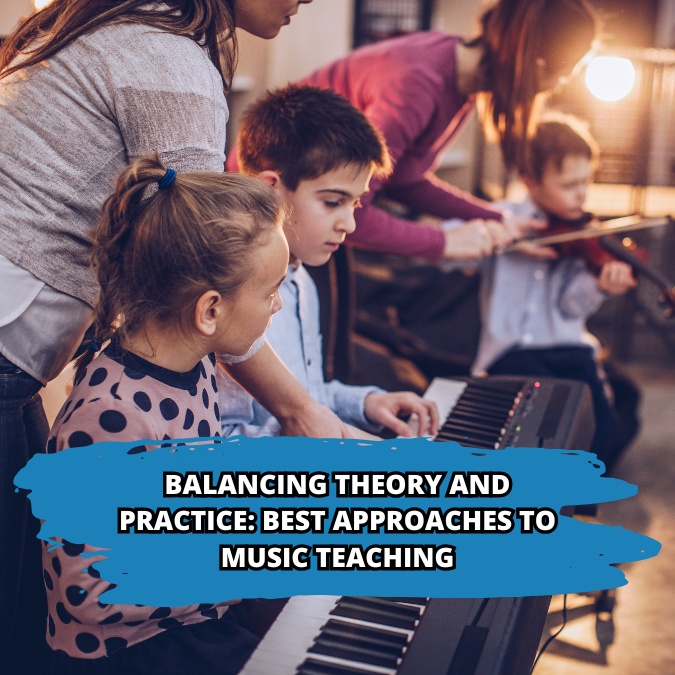Balancing Theory and Practice: Best Approaches to Music Teaching

The Importance of Music Theory in Education
Building a Strong Foundation with Theory
Understanding music theory is essential for students to build a comprehensive foundation in music education. It equips students with the ability to read and write music, facilitating deeper learning and creativity. Music theory acts as the grammar of music, providing a set of rules that guide composition and performance. By mastering these concepts, students can become more confident and versatile musicians.
Common Misconceptions About Music Theory
Many students view music theory as overly complicated or disconnected from the act of playing an instrument. This belief can hinder progress, as theory is integral to understanding why certain musical patterns work. Music teaching that incorporates real-world examples can demystify these misconceptions, showing students how theory enhances performance. Teachers who relate theory to familiar songs or genres help bridge the gap between abstract concepts and practical application.
The Benefits of Understanding Music Theory for Students
Students who understand music theory gain a competitive advantage, enabling them to adapt to different musical situations more easily. Comprehension of scales, chords, and harmonic progressions makes it easier for students to pick up new pieces and improve their improvisation skills. Music teaching that emphasizes theory helps students build better analytical skills, making them more adept at composing and arranging music. This foundation also allows for more confident interpretation during performances.
The Role of Practice in Mastering Music
Practice as a Pathway to Skill Development
Regular practice is the backbone of skill development in music teaching. Consistent practice builds muscle memory, ensuring that students can perform pieces smoothly and confidently. It also allows students to refine their technical abilities, making complex movements more intuitive over time. Teachers who encourage structured practice routines help students build discipline and resilience, which are essential traits for musicianship.
How Regular Practice Reinforces Theoretical Knowledge
Practice sessions that include theory-based exercises help students see the practical application of what they learn. For example, practicing scales not only develops finger strength but also reinforces the understanding of key signatures and tonal structures. Music teaching that integrates theory into practice helps students recognize the connections between the notes they play and the theoretical principles behind them. This approach deepens their knowledge and strengthens their overall performance.
The Impact of Repetition and Muscle Memory on Performance
Repetition is vital for developing muscle memory, allowing students to play complex pieces with accuracy. This is especially important in Music Teaching, where technical proficiency can make the difference between an average and outstanding performance. By repeating sections of music, students gradually develop the ability to play fluently without conscious effort. Muscle memory also reduces performance anxiety, as students feel more prepared when they can rely on ingrained patterns.
Striking the Right Balance Between Theory and Practice
Integrating Theory into Practice Sessions
Teachers should design practice sessions that naturally incorporate theoretical concepts to maintain a balanced approach. For instance, assigning exercises where students identify and play intervals or chord progressions can enhance both their technical skills and theoretical understanding. Music teaching that blends these elements helps students appreciate the value of theory when applied in a practical context. This integration makes learning more dynamic and less compartmentalized.
Techniques for Combining Theory and Practice
Seamlessly To combine theory and practice effectively, teachers can use a “learn and apply” method. This involves teaching a concept, such as a specific scale or chord progression, and immediately using it in practice through exercises or compositions. Music teaching can be enriched by using tools like composition apps or digital notation software to merge theoretical learning with hands-on creation. These techniques make lessons more engaging and show students the relevance of what they are learning.
Adapting the Balance for Different Learning Styles
Different students have varying learning preferences, and Music Teaching must adapt to accommodate these styles. Visual learners may benefit from sheet music and diagrams that illustrate theoretical concepts, while auditory learners might respond better to listening exercises that link theory to sound. Kinesthetic learners often prefer learning by doing, such as practicing chord inversions on an instrument as they learn about them. Adapting lessons to these styles ensures a more effective balance between theory and practice.
Practical Examples of Merging Theory and Practice
Exercises for Theory-Infused Practice
One effective exercise is for students to play scales while naming the notes aloud, reinforcing both theoretical knowledge and finger familiarity. Teachers can also ask students to compose short pieces using specific scales or chord progressions learned in class. Music teaching that involves breaking down popular songs into their theoretical components helps students see how theory applies to music they know and enjoy. By merging exercises like these, students develop practical skills and theoretical insight simultaneously.
Demonstrating Theory Through Performance-Based Activities
Having students perform pieces that highlight specific theoretical elements is a powerful teaching strategy. For example, playing compositions that showcase modulations helps students understand key changes in a real-world context. In Music Teaching, choosing repertoire that emphasizes counterpoint or harmonization can make theory lessons come to life. Performance-based activities should include guided discussions to solidify what students learn through these experiences.
Using Improvisation to Enhance Both Theory and Practical Skills
Improvisation is an excellent method for applying theory in a creative way. Encouraging students to improvise within a set chord progression helps them understand harmonic relationships. This technique in Music Teaching not only reinforces theoretical concepts but also promotes creativity and confidence. Improvisation can be practiced as a class activity, where each student takes turns playing a part, allowing for collaborative learning.
Challenges in Balancing Theory and Practice
Addressing Student Resistance to Music Theory
Some students resist learning theory because they see it as disconnected from the fun of playing music. To counter this, teachers should show how theory can empower students to play more expressively and explore new genres. Music Teaching can involve relating theory to songs students already love to play, demonstrating how understanding the structure can improve their performances.
Overcoming Practice Fatigue
Practice fatigue can set in when students repeat exercises without variation or clear purpose. To maintain enthusiasm, music teaching should incorporate varied exercises, such as alternating between technical drills and playing favorite pieces. Setting achievable short-term goals can help students track progress and stay motivated. Teachers can also use practice logs to ensure that practice time is both structured and balanced, preventing burnout and encouraging steady growth.
Customizing Lessons for Varied Skill Levels
Balancing theory and practice becomes more complex in a classroom with students of different skill levels. Teachers must be adept at modifying exercises so that they remain challenging for advanced students while still accessible to beginners. This might involve assigning more complex theoretical analysis to advanced students while others focus on simpler applications. Music teaching that employs tiered activities ensures that all students can progress at their own pace without feeling left behind.
Tips for Music Teachers to Maintain a Balanced Approach
Monitoring Student Progress Effectively
Consistent assessment helps music teachers gauge how well students are balancing theory and practice. This can involve regular quizzes on theoretical concepts alongside performance evaluations. Music teaching should include feedback sessions where students are made aware of their strengths and areas for improvement. Documenting progress also motivates students by showing them how far they have come and what they can achieve with continued effort.
Creating Engaging Lesson Plans
Lesson plans should incorporate elements of both theory and practice, ensuring that neither is neglected. For example, a plan could start with a brief theory discussion followed by exercises that put that knowledge into practice. Music teaching that uses multimedia tools, such as videos or interactive software, makes lessons more captivating. Engaging plans should also include room for creativity, such as improvisation or student-led discussions.
Encouraging Self-Directed Learning in Students
Self-directed learning fosters independence and can deepen a student’s understanding of music. Teachers should guide students on how to explore theory and practice outside of structured lessons. Providing resources such as recommended reading materials, apps, and online tutorials helps students take charge of their learning. Music teaching that empowers students to set their own goals promotes a lifelong appreciation for music and continuous improvement.
The Long-Term Benefits of a Balanced Music Education
A balanced approach to theory and practice provides students with a well-rounded music education. When theory is seamlessly integrated with practice, students become more skilled, confident, and adaptable musicians. Music teaching that emphasizes both elements encourages not only technical proficiency but also creativity and analytical thinking. Over time, this comprehensive approach prepares students for various musical opportunities, whether they pursue performance, composition, or teaching themselves.
FAQ
Q: Why is music theory important in music teaching?
A: Music theory is essential because it provides a foundation for understanding the structure and language of music. It helps students read, write, and interpret music, making them more versatile and confident musicians.
Q: How can teachers make music theory more engaging?
A: Teachers can make music theory more engaging by relating it to familiar songs and incorporating practical examples during lessons. Demonstrating how theory is used in popular music can bridge the gap between abstract concepts and real-world application.
Q: What are some strategies to integrate theory into practice?
A: Strategies include having students play scales while identifying the notes, using theory-based exercises, and improvising within set chord progressions. Combining theory and practice in lessons helps reinforce both aspects simultaneously.
Q: How can teachers prevent practice fatigue in students?
A: To prevent practice fatigue, teachers should vary practice routines and include a mix of technical drills, creative activities, and favorite pieces. Setting clear short-term goals and tracking progress can also help keep students motivated and engaged.
Q: Why is balancing theory and practice important in music teaching?
A: Balancing theory and practice is important because it creates well-rounded musicians who understand both the technical and expressive aspects of music. This comprehensive approach equips students with the skills needed for performance, composition, and lifelong learning.


